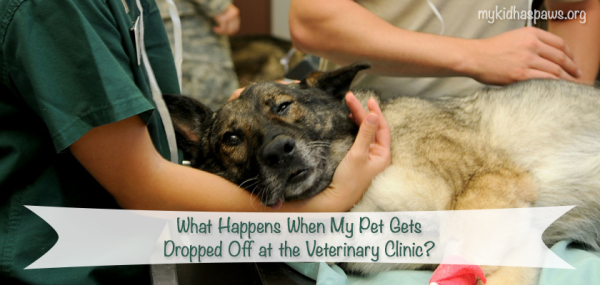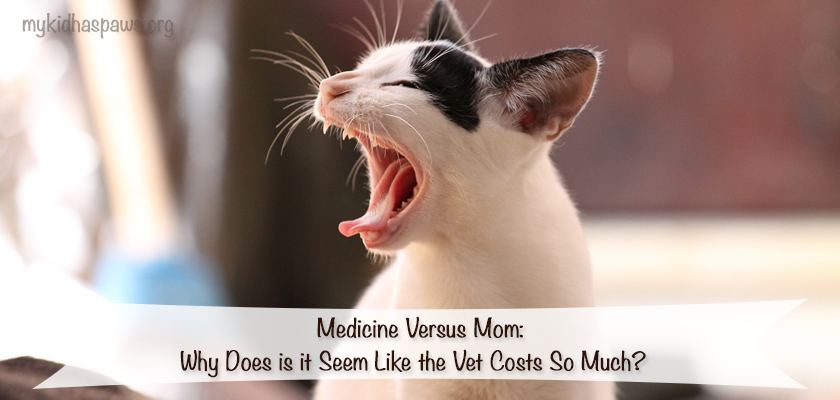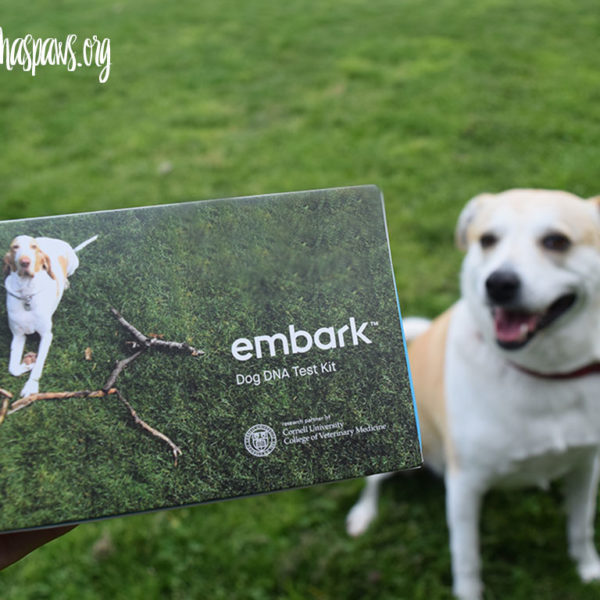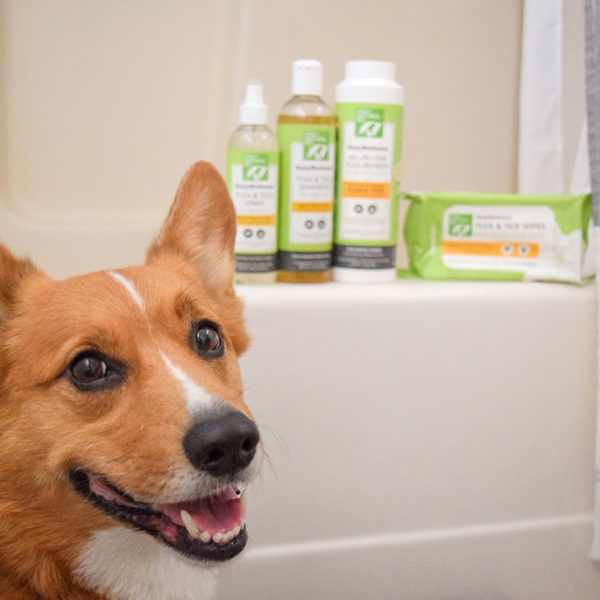
Carol Byrant from Fidose of Reality and I have matched up to bring you a veterinary experience from a mom and veterinary technician’s perspective. I will be writing from the veterinary technician’s perspective in order to bring you some insight into what happens “in the back” of a veterinary hospital.
Please keep in mind that every veterinary hospital will have its own unique processes and procedures, so this post will be a direct reflection of my experience working in veterinary hospitals.
Today we want to answer the question, “What happens when my pet gets dropped off at the veterinary clinic?”.
For example, let’s say that your dog is being dropped off for a dental including full anesthesia, and possibly 2 teeth extractions. Estimated surgery time is 20 minutes, and total estimated anesthesia time is 45 minutes. The staff will use the additional anesthesia time to clean and polish the teeth either before or after the extractions.
The Drop off (8:00am): When your pet is dropped off in the morning, the first thing we do is weigh your dog, and get them checked in with the standard paperwork. The reason we weigh your pet the morning of surgery is that we want to make sure they haven’t gained or lost a significant amount of weight since their last exam, because that could be a sign of a possible medical issue. We also want to make sure that the anesthesia calculations use the most recent and accurate weight, since doses are calculated based on weight.
If the veterinarian who is doing surgery that day (this would apply in a multi-veterinarian practice) is already in the hospital, they may give your dog a physical exam before we put your dog in a cage. The purpose of the physical exam is to make sure your pet is in good health, and has no signs of any medical issues before we begin prepping for surgery.
If your pet’s physical exam goes well, we will go ahead and calculate their pre-med. The pre-med works as both a pre-anesthetic and a pain medication. Basically, this will start making them sleepy and serve as pain control before, during, and after surgery.
Your dog’s critical information, and reason for surgery will be placed on a whiteboard, and a name card will be placed on their cage. This helps the staff know who is in the hospital, and what treatments they will need throughout the day. Many procedures vary across hospitals, but this procedure of writing patients on the white board was true for every hospital where I have worked.
Pre-Op (9:30am): If your dog is first in line for surgery that day, we might already be in surgery with your dog. However, on any given day we could have 3 or 4 surgeries, so your dog may not be going into surgery until 11:00, or 11:30am. Feel free to ask what time your pet is expected to go into surgery, but be prepared for this time to change, as we never know what the day will bring. Around this time in the morning, we will be placing catheters in all pet’s who need surgery that day.
Placing a catheter can be an uncomfortable process, but we have already given them their pre-med, so your dog will be much more comfortable. At this time, we will also be setting up all necessary items for your dog’s dental procedure.
Surgery (10:00am): A 10:00am surgery time would be typical for a pet who was 2nd or 3rd in line for surgery that day. At this time, your dog will be comfortably under anesthesia, and your veterinarian will likely be performing the teeth extractions. The length of time to extract teeth will vary based on the location of the teeth and the quality of the roots. For example, if your veterinarian is extracting a tooth in the vary back of your dog’s mouth, and the tooth is so rotten that the roots start to crumble as the tooth is being extracted, this may lead to a long extraction time because your veterinarian will want to make sure that all roots have been removed otherwise they could cause your dog issues down the road.
Post-op (11:00-noon): After your dog’s surgery is over, we will start to wake them up. We turn off the gas anesthesia and keep them intubated, depending the quality of their other vitals, we may decide to keep them on IV fluids at this time. Your dog will start to show signs of waking up within the next few minutes depending on how affected they are by the anesthesia. As your dog is waking up from surgery, they are with a veterinary technician the entire time. While waking a patient from anesthesia we are sitting or laying with them in their cage so that they feel comfortable when then wake up.
Anyone who has had anesthesia knows that your initial wake up can be very confusing. So we are sure to be there to let them know that they are okay, and we also assess their vital signs to make sure their body is recovering from anesthesia well.
Normally, this is the time that the veterinarian will give you a call to let you know that your dog’s surgery went well, and they are comfortably recovering from surgery. However, if an emergency walks through the door (like I said you never know), your veterinarian may have to postpone their call to you another 30 minutes to an hour, so patience is key at this time. I always remind pet parents that if your pet were the one with the emergency, you would want your pet to have veterinarian’s full attention at that time.
Post-Op (noon-5pm): Most of our surgery patients get picked up between 4:30pm and 5:30pm. We typically decide what pickup time will be when your veterinarian provides you with your post-op call. During these post surgery hours, the veterinary technician on the surgery will continuously assess your dog’s health. Meaning, we constantly check on our patients. Because we spend significantly less time in rooms with clients than the veterinarian does, and we are always in the back, it is our job to make sure all post-op patients are perky, and recovering with appropriate energy. We make sure to keep them warm and comfortable, and also prepare all of their post-op medications that will be going home with you.
Sometimes we would send a picture of the patient to the client’s cell phone (if they provided the number), with a message saying something like…”Hi Mom! I am recovering well from surgery, and I can’t wait to see you when you pick me up at 5:00pm”. I think pet parent’s really liked this, and I hope other clinics would do the same.
At 5:00pm you get a chance to see your pet, and we update you on their surgery and send you home with all necessary information and prescriptions. We always go over with you the signs of pain or discomfort that you as a pet parent should watch out for:
vomiting
diarrhea
panting
extended lethargy
and other surgery specific symptoms
If you have any questions now is the time to ask, but don’t be afraid to call the next day with further questions. We would rather you ask than worry!
Please remember while your pet is at the veterinary office, no news is not necessarily bad news. Like I mentioned previously, we could have 3-4 emergencies walk in before 9:00am and completely change the course of the day, so please be patient. Your veterinarian wants to update you just as much as you would like to be updated.
Hop on over to Fidose of Reality to get Carol’s perspective of the day as a dog mom!




Kyla
October 20, 2014 at 10:52 pmI’m a vet surgery vet-many times over. I don’t want them sending my picture-I’d crack the camera lens, the phone company and the peep’s phones.
Kyla recently posted…Prepping for next week
Rachel
November 2, 2014 at 7:18 amKyla you are sooo funny!
Ann Staub
October 21, 2014 at 12:31 amYep, this sounds about right! I can see some very minor differences in some of the places where I have worked, but they are just too small to really make much of a difference. It will be interesting to see what Carol has to say 🙂
Ann Staub recently posted…How a Fish Oil Supplement Helped My Dog’s Skin and Coat #WellyTails
Rachel
November 2, 2014 at 7:18 amThanks Ann for stopping by!!
Christine & Riley
October 21, 2014 at 1:24 pmI just loved this article and can’t wait for more to follow. I will definitely share this with my readers! Thanks so much for all the back room insight.
Christine & Riley recently posted…Monday Mischief: Lure Course Shih Tzu
Rachel
November 2, 2014 at 7:18 amThank you so much for sharing Christine!!
M. K. Clinton
October 21, 2014 at 6:23 pmThanks for a great post. It is always so scary to leave our pets for any type of procedures. This makes it a little easier. ☺
M. K. Clinton recently posted…BFTB Channel 7 NETWoof News for 10~20~2014
Rachel
November 2, 2014 at 7:19 amThanks Melissa, that was certainly my home.
Sharon S.
October 22, 2014 at 3:10 pmI love the concept of this post. There is nothing more troubling than dropping off your pet at the veterinary office for a procedure and wondering what is going on all day long.
Sharon S. recently posted…5 Tips For Adopting A Paralyzed Dog Or Cat
Rachel
November 2, 2014 at 7:19 amThanks Sharon! I hope this brings some comfort to pet parents everywhere!
Laila Keirstead
May 14, 2015 at 6:45 amI didn’t know you could drop off your pet at the vet clinic. That would be nice to do because I usually end up just sitting there for hours until my dog gets out of his appointment. I don’t know how my dog would do if I just left him there while I went shopping. He is a pretty nervous and shy dog. I don’t think he would like it if I left him.
Johnny
May 27, 2015 at 1:34 pmI think sending them text updates is a great idea. I would love to receive a text like that. That is definitely a fun way to know that you pet is doing good. This was fun to read. Thanks for sharing.
Rachel
June 23, 2015 at 2:05 pmJohnny, thank you so much for reading! Text updates were fun and pet parents loved them! Now that I don’t work there any more, my friends send the pictures to me still, and it is so nice to see they are doing well.
Emily Merrell
June 17, 2015 at 2:27 pmWow, this is a really great article to help any new pet owner. I have taken my dog to the vet many times, so I know exactly what happens there. Some vets actually let you watch the whole procedure. A lot of times that helps your dog to be more calm.
Rachel
June 23, 2015 at 2:44 pmHI Emily, thank you so much for sharing! Yes, I think it definitely helps when pet parents know what is happening while they aren’t there. 🙂 I have known a few vets to let some clients see procedures. Even if I hadn’t worked in vet med, I think I would want to know. I am always a fan of more information.
Audrey Blakeney
June 23, 2015 at 8:38 amI appreciate you explaining what happens when you drop you dog off at the clinic or animal hospital. Like you, my dog is part of the family, and not being able to be with him as I would with one of my own children at the hospital is hard to cope with. Having describe the process helped ease some of my stress and nerves about dropping my dog off for surgery next week. As a fellow pet owner, thank you.
Audrey Blakeney recently posted…September Pet of the Month: Bailey
Rachel
June 23, 2015 at 3:04 pmAudrey, no problem! Thank you for reading! I hope all goes well next week and please let me know if you have any questions.
bryan flake
July 27, 2015 at 3:39 pmIt seems almost natural to let my teenagers go back to the doctors exam room by themselves. However, it makes me nervous to let the vet take my dog to the back, without me being there. I am worried that my dog will be scared and cause problems or something, I guess.
Ace Pet Care in Austin
August 31, 2015 at 4:32 amThank you for this full explanation. This will really help pet moms and dads help relieve some of the stress of seeing their furkids go off for procedures. I really liked this! Thank you.
Ace Pet Care in Austin recently posted…Austin Surfaces and Healthy Dog Paws
Veronica Marks
September 15, 2015 at 2:43 pmThis is such a great article for any pet owner! Thanks for being so descriptive, particularly with including a timeline. For so many people whose pets are their babies, having information like this bring so much peace of mind.
Wendy Cartright
October 2, 2015 at 3:08 pmMy poor pug’s back teeth have been bothering her so much lately. She has been having a hard time eating anything. I am probably going to have to take her to the vet soon to have the problem teeth removed. Thank you for sharing this helpful information!
John Anderson
November 17, 2015 at 5:46 pmThis info is good to know. Surgery on a human is scary, can’t imagine what a pet is thinking. I like how the article posts what to look for after the surgery, like vomiting, diarrhea, etc. Those will be helpful to pet owners.
Hazel Owens
March 9, 2016 at 5:17 amThis is great! I wondered what was going on behind the scenes when my dog had some surgery, and why it took so long. It’s good to know that the whole time she was in the clinic, she was being taken care of by vets who were making sure everything went well. I’m glad to wait an extra few hours to pick my dog up from the clinic if it means that her health and safety is being checked, because the vets know what they’re doing much better than I do. Plus, if it means I don’t have to come in later to deal with a looked-over issue, that saves everybody the time and stress of another visit.
Rachel
March 9, 2016 at 7:13 amHi Hazel! I am glad you found this post useful! Yes, there is a lot of checking in and monitoring that happens when your pet is staying in the hospital. Veterinarians and their staff typically encourage transparency, so feel free to ask for calls or picture updates when your pet is in the hospital!
Mary Nielsen
April 2, 2016 at 6:19 pmI love the part when you personally message your clients with their pet’s recent picture. It gives them a proof that their pets are well taken care of by a trustworthy person. I once had a bad experience in a veterinary clinic that led me to stereotyping all the vet clinics in the world hahaha. My mom also believes that our dogs will recover faster when personally taken care at home with some medications. We always need help from professionals, but our pets will always need our love and care. Thanks for letting me know not all vet clinics are the same!
Paul Langley
April 11, 2016 at 2:59 pmThis is some really great information for any pet owner. I don’t know a single person who doesn’t worry about their pet at the vet, but this is really reassuring and helpful outline of what a visit is like. I really like the way you send pictures to the proud pet-parents, that sounds like it would definitely make me feel a little better. Thanks so much for writing!
Kenneth Gladman
April 12, 2016 at 12:57 pmThank you for sharing, it is nice to know he had someone there while he was coming out of surgery. It sounds like all went well and that you have a really good vet. My lab goes in for a procedure next month.
John Carston
May 12, 2016 at 6:06 amI’ve had to use an emergency veterinary service for a pet before but I didn’t really know all that happened once my pet had been dropped off. This post has been very interesting for seeing what all happens with my pet at the vet. Thanks for the helpful vet vet post.
Silas Knight
June 15, 2016 at 12:53 pmI have always worried what actually happens to my pet at the hospital. I like how open and honest you are in this article, explaining what goes on behind the scenes in the hospital. How many surgeries do you normally have, on a given day?
Rachel
June 16, 2016 at 4:23 pmI don’t actively work in a hospital any more, but from my experience on any given day we might have 2-4 surgeries in a day.
Abélia
August 26, 2016 at 11:29 amI’ve always wondered what happens when my pet gets dropped off at the vet. Thank you for providing this interesting insight into veterinary procedures. It’s good to know that a veterinary technician is with the dog when they wake up after surgery. I definitely agree that it’s important that my pet has the veterinarian’s full attention at the time of treatment.
Kevin
January 8, 2017 at 8:14 amI just loved this article and can’t wait for more to follow. I will definitely share this with my readers! Thanks so much for all the back room insight.
Kevin recently posted…Best Dog Shock Collar Reviews – Buyers Guide In 2017
Rachel
January 9, 2017 at 5:23 pmThank you for sharing Kevin! I am glad you enjoyed the post!